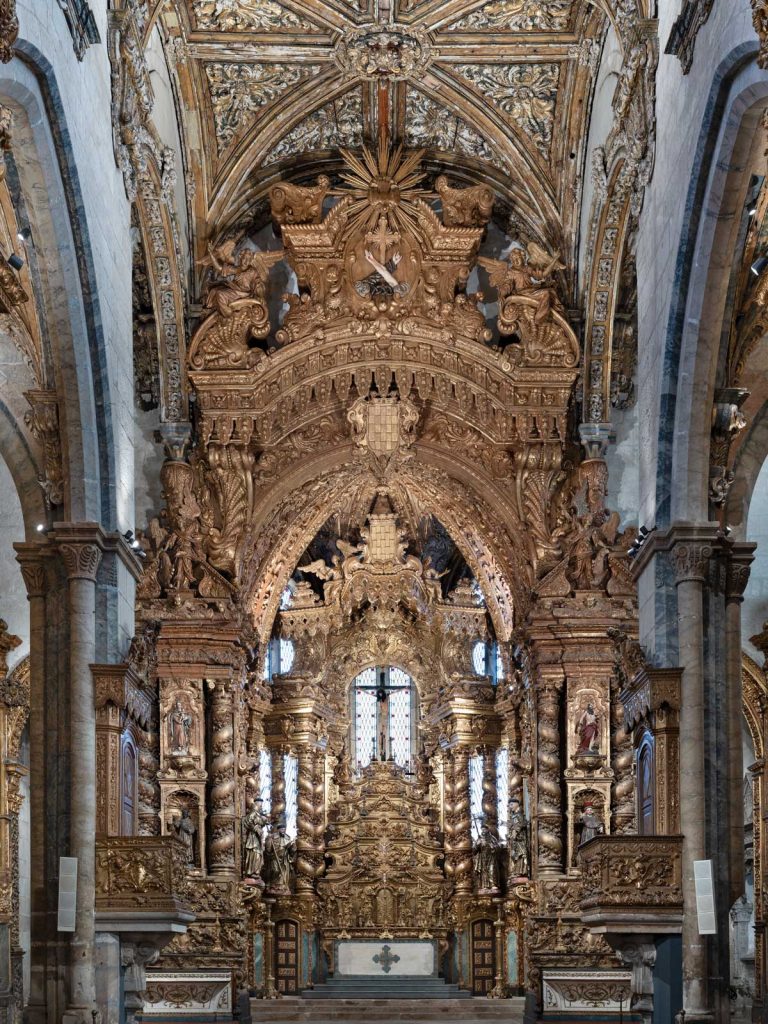
Retábulo-mor
altares colaterais e púlpitos
Data: c. 1740/1753
Período/Estilo: Barroco Final ou Joanino
Entalhador: Atribuídos a Manuel da Costa Andrade
O retábulo-mor, de grande monumentalidade, prolonga-se pela talha do tecto e as paredes da capela-mor, ligando-se aos retábulos do transepto e à gigantesca sanefa do arco-cruzeiro criando um conjunto único e impressionante de talha dourada que, segundo o historiador de arte americano Robert Smith, constituiu a maior composição cenográfica de Portugal.
Todo o conjunto, atribuído ao entalhador Manuel da Costa Andrade, terá sido executado entre 1740 e 1753, em estilo joanino ou barroco final. Com inspiração na linguagem do Barroco italiano, podemos observar toda uma riqueza ornamental dinâmica e teatral, com festões e grinaldas, flores suspensas, anjos com posições teatrais, cabeças aladas, cortinas com borlas, etc.
O retábulo-mor ensaia um modelo novo em Portugal, o retábulo tipo baldaquino que cobre o trono central, em degraus, que servia para a exposição do Santíssimo no seu topo, numa custódia. Actualmente, encontra-se nesse local uma imagem de Cristo crucificado. Todo o conjunto é rematado pelas armas dos Sá, família a quem a Ordem havia concedido, desde o século XVI, a capela-mor para seu panteão familiar. O mesmo se repete na grande sanefa do arco cruzeiro, à entrada da capela-mor. Aqui, mais acima, também se pode observar o brasão com as armas da Ordem Franciscana: o braço desnudo de Cristo cruza-se com o de São Francisco, simbolizando o abraço do Santo ao Crucificado no momento em que foi estigmatizado por Cristo. Ao centro, a cruz e a coroa de espinhos completam as armas dos franciscanos.
No altar-mor destacam-se as figuras de São Domingos (à esquerda) e de São Francisco (à direita), representando a relação próxima entre as duas ordens mendicantes. Nas paredes laterais da capela-mor, encontram-se as imagens de São Sebastião e São Tiago das Marcas (no lado do direito) e de São João do Prado e São João de Capistrano na parede oposta.
Os quatro altares colaterais tiveram de adaptar-se à reduzida largura das paredes entre as capelas e à elevada altura do transepto, obrigando a uma solução invulgar na organização estrutural dos seus andares, acrescentando-se mais registos no embasamento (três em vez dos habituais dois) e criando um corpo com duas figuras santas em nichos sobrepostos, ou relevos. Desta forma obteve-se maior grandiosidade e um melhor enquadramento deste conjunto no espaço.
Da direita para a esquerda encontramos:
Altar de Nossa Senhora das Candeias – Com os bustos relicários de São Francisco de Sales e de São Francisaco Néri, encimado por Relevo representando Cristo Ressuscitado.
